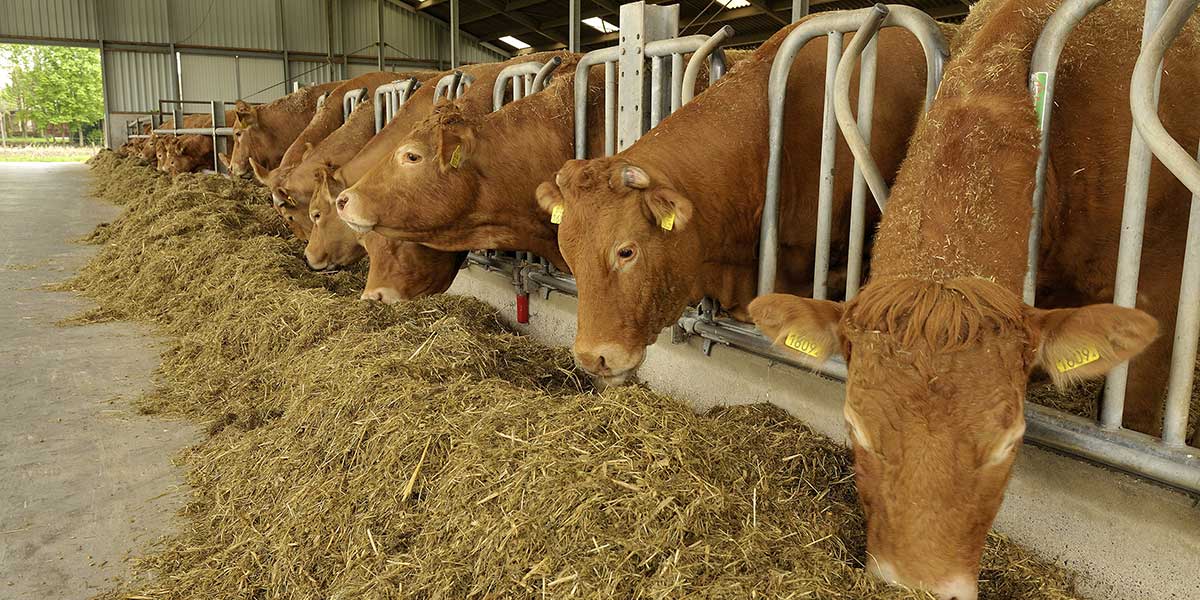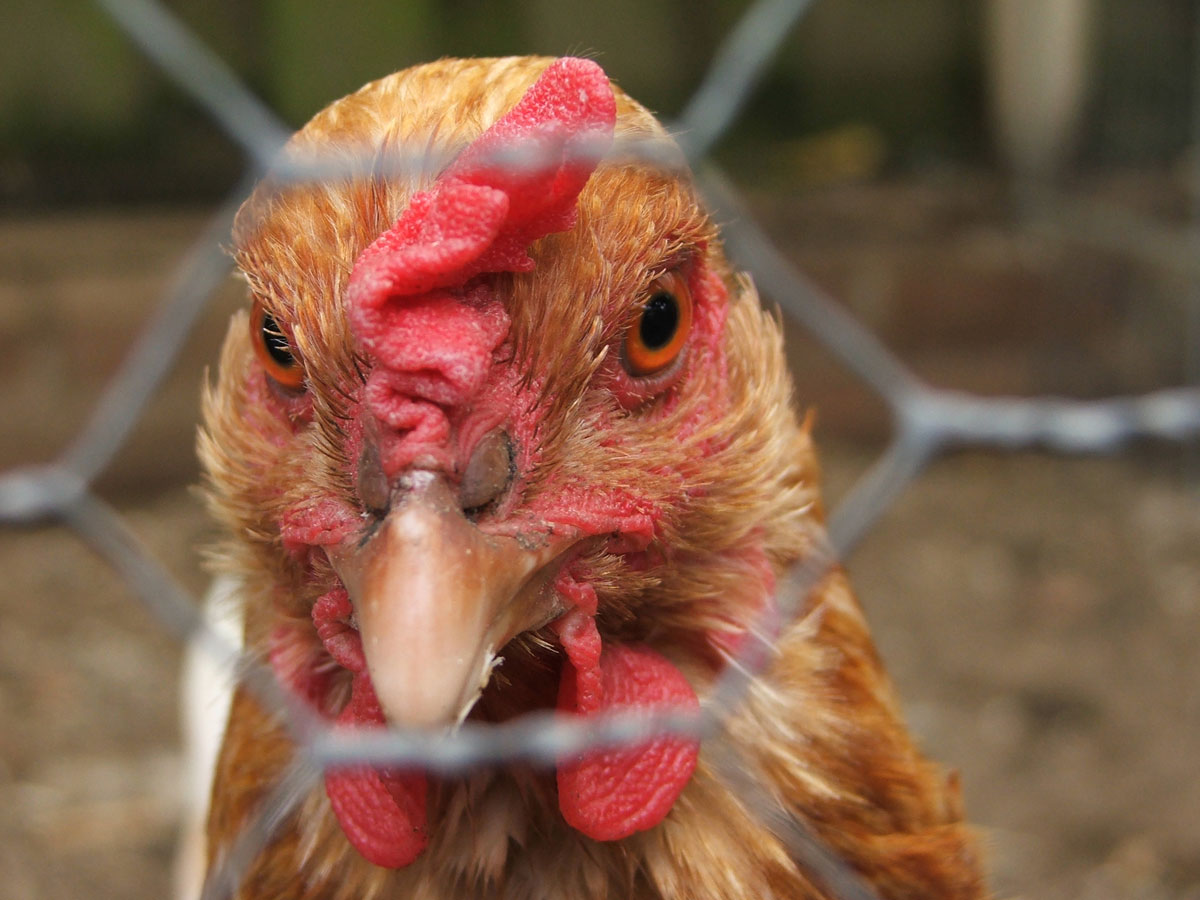The homesteading movement in the United States represents a return to “first principles,” chief among which is self-sufficiency; and two of the cornerstones of this burgeoning movement are “do-it-yourself” and “grow-your-own.” Now that Spring is just around the corner, what better time to put both these ideas into action at once than to build your own backyard chicken coop?
It’s easier than you might think! More importantly, the overall benefits far outweigh the initial investment and effort. The endless supply of farm-fresh eggs alone is worth the price of admission. Without the added chemicals and hormones you might expect from mass commercial egg production, they’re healthier for you, they taste noticeably better, and they’re available at a moment’s notice just a few feet from your kitchen. Likewise, if you use the birds for meat, they grow fast, don’t take up much space, and more than pay for themselves in reduced grocery bills. Last but not least, it’s fun to raise your own chickens—it’s something that you and your whole family can learn from and enjoy in its own right.
A basic setup need not be an elaborate affair. This article will help you get started.
Preliminaries
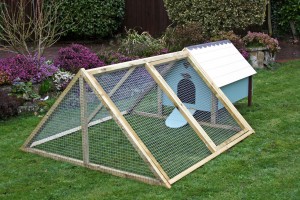
To build a backyard chicken coop, first you will need—well, a backyard. If you live in a city, the “yard” can be the roof of your building (landlord permitting). All that matters is that the space be adequate for the number of birds you intend to keep. Different breeds of birds have varying needs. The rule of thumb is to allocate 2–4 square feet of space per bird inside the coop itself and 4–6 square feet for the outside chicken run. That works out to about 40 square feet in total (i.e., 5′ × 8′) for a brood of five birds.
Next, you will need to make sure your local ordinances and zoning laws allow for homeowners to raise poultry on the premises. Be aware that a town may allow you to keep a certain number of hens—but not roosters (don’t want to wake the neighbors!).
Once you’ve made the decision to build and received the official okay, set aside a full weekend (or two, depending on the size of the coop and your carpentry skills) to complete the project.
Planning
Unless you’re a master builder, it’s best to begin with clear, accurate blueprints or instructions for the project. Humans have been raising domestic fowl for thousands of years, so there is no lack of resources to refer to. There are many books on the subject (you will find some suggested reading at the end of this article). And a quick search on the computer will reveal that the Internet is absolutely overflowing with free, downloadable building plans for chicken coops.
Whichever one you choose, be cognizant of these four essential considerations when designing and building the ideal space for your birds:
- Providing adequate living area (inside and outside) for each bird
- Ensuring the interior space stays dry and is well-ventilated
- Maintaining proper temperature control
- Protecting the birds from predators
The main thing to keep in mind is that you are building a home for your birds. And like any home, it can be either simple or elegant or downright fancy. But in the end, however big or small your budget, all that matters is that the coop be clean, comfortable, and safe.
Happy home = happy birds!
Tools and Materials
Just like your home, the project has two primary components:
- The Inside, or the “house” itself (i.e., the coop), which provides shelter and a space for nesting and sleeping at night; and
- The Outside, or the “yard” (i.e., the chicken run), for exercise and fresh air during the day.
 As far as tools are concerned, you don’t need much. Most if not all the implements required can be found in just about any homeowner’s workbench or garage, and include: a saw (hand-powered or electric), drill, hammer, screwdriver, wire cutter, shovel, and measuring tape.
As far as tools are concerned, you don’t need much. Most if not all the implements required can be found in just about any homeowner’s workbench or garage, and include: a saw (hand-powered or electric), drill, hammer, screwdriver, wire cutter, shovel, and measuring tape.
As for materials, all are readily available at most any lumber or building supply store; or you can recycle materials already at hand. These include:
- Lumber—e.g., 4×4s for posts, 2×4s for framing, plywood for the roof, etc. (Note: Since pressure-treated wood contains heavy metals such as arsenic, which can be harmful to your chickens’ health, it is best to use naturally rot-resistant lumber, such as redwood or cedar, especially inside the coop.)
- Several bales of mesh chicken wire for the enclosure
- Waterproof shingles for the roof
- Miscellaneous hardware manufactured for outdoor use, such as galvanized nails, decking screws, hinges for access doorways, and lockable latches to keep out predators
Putting It All Together
As with any building project, the first rule is: Measure twice, cut once. Sticking with the plan and taking accurate measurements ahead of time will save you money and help you avoid coming up short on materials midway through the project. Otherwise, the key factors to keep in mind as you build are as follows.
Location
 When marking out the area for the coop structure and chicken run, make sure it is on relatively high ground so as to avoid flooding problems and constant mud. It can be either freestanding or attached to the outside wall of your house. In addition, consider its location relative to the sun. A southern exposure ensures more warmth in the winter and a greater amount of sunlight year-round. At the same time, if it is situated under a leafy tree, the birds can stay cool in the tree’s shade during the hot summer months. If no suitable tree is available, you will need to shield the run with an awning or light tarp.
When marking out the area for the coop structure and chicken run, make sure it is on relatively high ground so as to avoid flooding problems and constant mud. It can be either freestanding or attached to the outside wall of your house. In addition, consider its location relative to the sun. A southern exposure ensures more warmth in the winter and a greater amount of sunlight year-round. At the same time, if it is situated under a leafy tree, the birds can stay cool in the tree’s shade during the hot summer months. If no suitable tree is available, you will need to shield the run with an awning or light tarp.
Elevation
The main living structure of the coop should be raised 2–3 feet above the ground to ensure your birds’ feet stay dry and to allow droppings to fall through the floor to the run area below, where they can easily be cleaned up. Make sure there is an opening in the wall for your birds to get in and out; and build a gently sloping ramp, at least 8 inches wide, from the ground level to the platform of the coop.
Insulation
Chickens of course enjoy natural insulation against inclement weather—their feathers! Nevertheless, extreme temperatures are not good for their health. Choose insulating materials appropriate for the seasonal weather conditions in your area. If need be, a good-quality heat lamp, safely positioned inside the coop, may be installed.
Ventilation
Even more important than insulation is ventilation. Stale, damp air inside the coop can make a brood sick and spread disease. The walls should be constructed tight for winter temperature control; however, your building plans should also include a window or vent near the ceiling to ensure good airflow year-round—but no drafts!
Perching Area
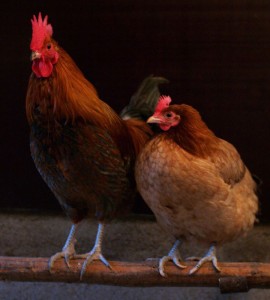 Like most other species of birds, chickens like to sleep while perched. Unlike wild birds, however, they prefer to roost flat-footed. So for this purpose, you can use a 2×4 or 4×4 with the edges slightly rounded, or even a thick, sturdy tree branch with the bark removed. The roosting bar should be positioned about 2–3 feet above the floor of the coop, and it should be long enough to accommodate all the birds at once (allow a minimum of 8 inches of length per bird).
Like most other species of birds, chickens like to sleep while perched. Unlike wild birds, however, they prefer to roost flat-footed. So for this purpose, you can use a 2×4 or 4×4 with the edges slightly rounded, or even a thick, sturdy tree branch with the bark removed. The roosting bar should be positioned about 2–3 feet above the floor of the coop, and it should be long enough to accommodate all the birds at once (allow a minimum of 8 inches of length per bird).
You can also have more than one bar for them to roost on, each staggered at different heights.
Be aware that chickens poop while asleep, so the bar should be situated away from their feeders, waterers, and nesting boxes, and in a convenient spot for scooping out the accumulated droppings.
Nesting Boxes
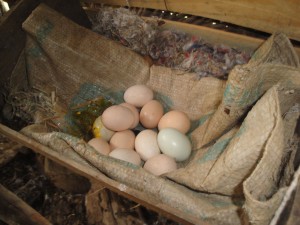
A full-grown, healthy, and well-fed hen can be expected to lay eggs every one or two days, and they like a dark, comfortable space in which to lay. Plan on one box per three hens. The boxes should be raised a couple of feet off the floor of the coop—but lower than any roosting bar(s) inside, so they are not tempted to roost on top of the boxes. Each box should be about a foot square, large enough for the hen to lay as many eggs as she likes, and sufficiently deep that she can keep the eggs warm and safe.
Fill the bottom of each box with pine wood shavings or straw, so the eggs have a soft place upon which to lie.
Other Accessories
You’ll also need watering devices for inside the coop and the chicken run, hung about 6 inches above the ground so the water supply doesn’t get fouled; and a feeding trough long enough to allow all the chickens to feed at once. Hens lay their eggs during the daytime, so optionally a lightbulb inside the coop can be installed to extend the laying hours. Line both the floor of the coop and the ground area of the chicken run with a thick layer of pine wood shavings or straw to absorb droppings and moisture.
Safety Concerns
The chicken run should be enclosed with mesh wire to keep the birds in and hungry animals out. If digging predators such as foxes, dogs, skunks, raccoons, weasels, or mink are a problem in your area, make sure to bury the chicken wire at least six inches deep around the entire enclosure.
Accessibility
Don’t forget, it’s not just the chickens who will be using their “home”—you will be too! Of course, you’ll need a gate with a raccoon-proof locking latch to get inside the main enclosure. But the coop itself should have a hinged/latched access door large enough and conveniently situated to allow you to reach or climb inside so you can fill the waterers and feeders, clean out soiled straw, and collect eggs.
Last But Not Least—Populate the Coop!
 Now that the grand project is completed, it’s time to acquire your brood and introduce them to their new home. You can buy baby chicks from a farm supply store or order them from a breeder or hatchery. For guidance in choosing the right breed for your purposes, see this article from Countryside Daily.
Now that the grand project is completed, it’s time to acquire your brood and introduce them to their new home. You can buy baby chicks from a farm supply store or order them from a breeder or hatchery. For guidance in choosing the right breed for your purposes, see this article from Countryside Daily.
And on the off chance that some of your chickens manage to get loose, make sure to protect your investment by stocking up on poultry leg bands from Ketchum Mfg. Co.
Some Additional Helpful Resources
BOOKS
 Building Chicken Coops
Building Chicken Coops
by Gail Damerow
This book reviews a bevy of chicken coop designs, ranging from utilitarian to high style. The collection of 45 building plans presented herein are sure to meet the needs of any chicken owner.
 Storey’s Guide to Raising Chickens
Storey’s Guide to Raising Chickens
by Gail Damerow
Learn to choose the right breeds for your needs, build efficient chicken coops, provide necessary medical attention for your animals, and much more.
LINKS
Backyard Chickens Forum
An online discussion board with many informative FAQs.
FeatherSite—The Poultry Page
An on-line zoological garden of domestic poultry, including photos, video, and information about various breeds of fowl, such as chickens, ducks, geese, guinea fowl, peafowl, pigeons, and turkeys.
♦ ♦ ♦
